(These materials and much more can be found on our (Cell Division CD-ROM)
Cell Division Overview
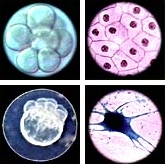
Clockwise, from top left:
embryonic sea urchin cells,
frog skin cells, neuron,
8-cell fish embryo.
All of the living organisms on Earth are made up of one or more cells, which are the simplest units of life capable of independent existence and reproduction. Cells have the extraordinary ability to make nearly identical copies of themselves by the process of cell division. Since new cells are only produced by existing cells, cell division is essential for the continuation of life.
There are a variety of reasons that might cause a cell to divide:
- Multicellular organisms grow in size and complexity by making more cells.
- Old and damaged cells are continuously replaced by the division of cells.
- Single-celled organisms such as bacteria divide to make new, independent organisms.
Two events are required for successful cell reproduction. First, the "parent" cell must ensure that each new "daughter" cell receives a complete copy of its hereditary information. This information is transmitted in the form of complex molecules called DNA, and directs the various activities of the cell throughout its lifetime.
The second requirement is the partitioning of cytoplasm between the two daughter cells.
The Cell Cycle
The orderly program of events in the lifetime of a cell is known as the cell cycle. One cell cycle describes the period between a cell's creation by mitosis, and its subsequent division into two daughter cells. The typical cell cycle is divided into two phases: a brief mitotic phase in which the cell divides its nuclear and cytoplasmic contents, and a longer period between divisions called interphase.
In eukaryotic (plant, animal & fungus) cells, the division of chromosomes and cytoplasm into two cells is known as the mitotic phase. During mitosis and cytokinesis, each of the two daughter cells will receive an exact copy of the parent cell's chromosomes and roughly half of the cytoplasm. A detailed analysis of mitosis is provided on our Cell Division 1 CD-ROM.
It is important to know that the parent cell's chromosomes are replicated during the S (synthesis) phase of the cell cycle before mitosis can begin. The replicates (called sister chromatids) remain attached to each other through early mitosis.
The Phases of Mitosis
Compare and contrast mitosis in the following plant and animal cell pictures:
Prophase
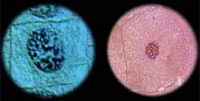
Plant and animal cells: prophase.
The beginning of mitosis is called prophase. In early prophase, the centrosomes move toward opposite poles of the cell, organizing the spindle microtubules between them. The sister chromatids become visible in the nucleus as they condense.
Metaphase
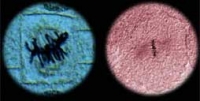
Plant and animal cells: metaphase.
The chromatids remain lined up between the poles of the cell during metaphase.
Anaphase
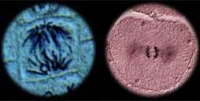
Plant and animal cells: anaphase.
Anaphase begins when the pairs of sister chromatids separate. The separated chromatids are now called chromosomes, and move toward the poles of the cell.
Telophase
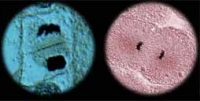
Plant and animal cells: telophase.
The chromosomes arrive at the poles in telophase, and new nuclear membranes form around them.
Cytokinesis
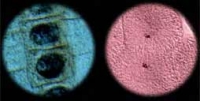
Plant and animal cells: cytokinesis.
Division of the cytoplasmic components is called cytokinesis.
In animal cells, cytokinesis occurs when a ring of actin and myosin filaments constricts the plasma membrane at the equator. Eventually, the parent cell is divided into two cells.
In plant cells, a number of small vesicles fuse at the metaphase plate to form the cell plate. Over time, the cell plate reaches across the cell and joins with the plasma membrane.
Interphase

Plant and animal cells: interphase.
The process of mitosis and cytokinesis creates two separate cells, each with an identical set of chromosomes. After cytokinesis, the daughter cells will enter interphase.
For additional information on mitosis in plant and animal cells, or prokaryotic cell division, see our Cell Division 1 CD-ROM.

 Watch the Cell Cycle movie.
Watch the Cell Cycle movie. Watch a real animal cell undergo mitosis.
Watch a real animal cell undergo mitosis. Watch an animation of plant cell mitosis.
Watch an animation of plant cell mitosis.
0 comments:
Post a Comment